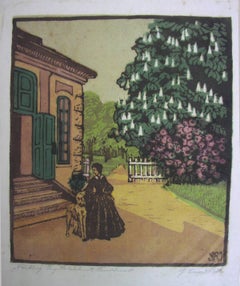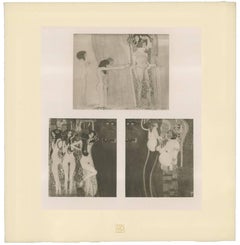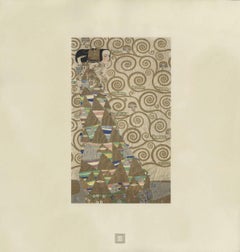Siccard-Redl, Josef. Art
to
1
Overall Width
to
Overall Height
to
1
1
1
1
1
1
1
1
1
1
9,475
2,687
1,375
1,358
1
Artist: Siccard-Redl, Josef.
Fruhling
By Josef Siccard-Redl
Located in New York, NY
Siccard-Redl, Josef. Fruhling, Ca 1910. Color wood engraving, Signed and titled in pencil by the artist.
Little is known of this artist other than he worked in Vienna during the
...
Category
1910s Vienna Secession Siccard-Redl, Josef. Art
Materials
Engraving
Related Items
H.O. Miethke Das Werk folio "Beethovan Frieze 1 & 2" set of collotype prints
By Gustav Klimt & K.K. Hof-und Staatsdruckerei
Located in Palm Beach, FL
DAS WERK GUSTAV KLIMTS, a portfolio of 50 prints, ten of which are multicolor collotypes on chine colle paper laid down on hand-made heavy cream wove paper with deckled edges; under ...
Category
Early 1900s Vienna Secession Siccard-Redl, Josef. Art
Materials
Paper
Max Eisler Eine Nachlese folio “Expectation” collotype print
By (after) Gustav Klimt
Located in Palm Beach, FL
After Gustav Klimt, Max Eisler #12, Aus dem Stoclet-Fries: Erwartung; multi-color collotype after the cartoon for the 1910-1911 mosaic frieze on the west wa...
Category
1930s Vienna Secession Siccard-Redl, Josef. Art
Materials
Paper
$12,000
H 19 in W 18 in
Max Eisler Eine Nachlese folio “Hygieia” collotype print
By (after) Gustav Klimt
Located in Palm Beach, FL
After Gustav Klimt, Max Eisler #10, Ausschnitt aus dem Bilde “Medizin”; multi-color collotype detail from Medicine, one of the faculty paintings for the Uni...
Category
1930s Vienna Secession Siccard-Redl, Josef. Art
Materials
Paper
$18,500
H 19 in W 18 in
Original Vintage Secession Poster celebrating the emperor's jubilee
Located in Zurich, CH
Original Vintage Poster by the Austrian artist Ferdinand Ludwig Graf, a member of the Hagenbund. This Viennese artist association moved as soon a...
Category
Early 1900s Vienna Secession Siccard-Redl, Josef. Art
Materials
Paper
$13,700
H 48.82 in W 36.42 in D 0.04 in
H.O. Miethke Das Werk folio "The Kiss" collotype print
By Gustav Klimt & K.K. Hof-und Staatsdruckerei
Located in Palm Beach, FL
The Kiss, no. 1 from the fifth installment of Das Werk Gustav Klimts
Undoubtedly Klimt’s best known and most reproduced images, this printed version of The Kiss is the only one with which Klimt was directly involved. Unveiled at Vienna’s Kunstschau 1908, and saved for the fifth and final delivery of Das Werk, The Kiss marks a triumph in Klimt’s career and represents a culmination of many themes in his oeuvre up to that point. After all of the controversy surrounding the State’s prior rejection of the University murals commissioned from Klimt, the Ministry of Education reversed their policy toward the artist with a show of wholehearted support by purchasing for the Osterreichische Galerie BelvedereThe Kiss while it still hung in the Kunstschau exhibit.
Considered in relation to the eight multicolored collotypes which preceded its print debut in the Das Werk portfolio, The Kiss literally embraces all which came before it. The golden seaweed dangling in tresses from the lovers’ feet harkens back to Water Snakes I and II. The bed of flowers evokes the settings Klimt created in both The Golden Knight and The Sunflower. In fact, this image sprung out of a particularly happy summer spent in the company of Klimt’s lover, Emilie Floge...
Category
Early 1900s Vienna Secession Siccard-Redl, Josef. Art
Materials
Handmade Paper
Max Eisler Eine Nachlese folio "Baby" collotype
By (after) Gustav Klimt
Located in Palm Beach, FL
After Gustav Klimt, Max Eisler Plate #25, Baby; black & white collotype after the 1917 painting in oil on canvas.
GUSTAV KLIMT EINE NACHLESE (GUSTAV KLIMT ...
Category
1930s Vienna Secession Siccard-Redl, Josef. Art
Materials
Paper
Max Eisler Eine Nachlese folio “The Bride” collotype print
By (after) Gustav Klimt
Located in Palm Beach, FL
After Gustav Klimt, Max Eisler #30, Brautzug; multi-color collotype after unfinished 1917/18 painting in oil on canvas.
Painted in the last months of Klimt’s life, The Bride was one...
Category
1930s Vienna Secession Siccard-Redl, Josef. Art
Materials
Paper
$8,000
H 19 in W 18 in
Gerlach's Allegorien, plate #46: "Love" Lithograph, Gustav Klimt.
By Gustav Klimt
Located in Palm Beach, FL
Klimt’s association with Martin Gerlach dates back to the early 1880s when Gerlach and Schenk published their first edition of Allegorien und Embleme. By the mid-1890s, they were pla...
Category
1890s Vienna Secession Siccard-Redl, Josef. Art
Materials
Lithograph
$18,500
H 17.25 in W 13.75 in
Max Eisler Eine Nachlese folio "Portrait of Serena Lederer" collotype
By (after) Gustav Klimt
Located in Palm Beach, FL
After Gustav Klimt, Max Eisler Plate #6, Bildnis Frau Serena Lederer; grey monochrome collotype after the 1905 painting in oil on canvas.
GUSTAV KLIMT EINE NACHLESE (GUSTAV KLIMT AN...
Category
1930s Vienna Secession Siccard-Redl, Josef. Art
Materials
Paper
Max Eisler Eine Nachlese folio "Portrait of Friederike Marie Beer" collotype
By (after) Gustav Klimt
Located in Palm Beach, FL
After Gustav Klimt, Max Eisler Plate #24, Bildnis Friederike Maria Beer; multi-color collotype after the 1916 painting in oil on canvas.
GUSTAV KLIMT EINE NACHLESE (GUSTAV KLIMT AN ...
Category
1930s Vienna Secession Siccard-Redl, Josef. Art
Materials
Paper
POLSTER (The Cushion)
By Max Kurzweil
Located in Santa Monica, CA
MAXIMILLIAN KURZWEIL (Austrian 1867-1916)
DER POLSTER / THE CUSHION, 1903. Color woodcut printed on laid japon paper, affixed as usual to a support sheet from its upper sheet edge...
Category
Early 1900s Vienna Secession Siccard-Redl, Josef. Art
Materials
Woodcut
Max Eisler Eine Nachlese folio “Adam & Eve” collotype print
By (after) Gustav Klimt
Located in Palm Beach, FL
After Gustav Klimt, Max Eisler #20, Adam und Eva; multi-color collotype after unfinished 1917/18 painting in oil on canvas.
GUSTAV KLIMT EINE NACHLESE (GUSTAV KLIMT AN AFTERMATH), a...
Category
1930s Vienna Secession Siccard-Redl, Josef. Art
Materials
Paper
Siccard-redl, Josef. art for sale on 1stDibs.
Find a wide variety of authentic Siccard-Redl, Josef. art available for sale on 1stDibs. You can also browse by medium to find art by Siccard-Redl, Josef. in engraving and more. Much of the original work by this artist or collective was created during the 1910s and is mostly associated with the Expressionist style. Not every interior allows for large Siccard-Redl, Josef. art, so small editions measuring 11 inches across are available. Customers who are interested in this artist might also find the work of Gustav Klimt & K.K. Hof-und Staatsdruckerei, Gustav Klimt, and Carl Otto Czeschka. Siccard-Redl, Josef. art prices can differ depending upon medium, time period and other attributes. On 1stDibs, the price for these items starts at $800 and tops out at $800, while the average work can sell for $800.


